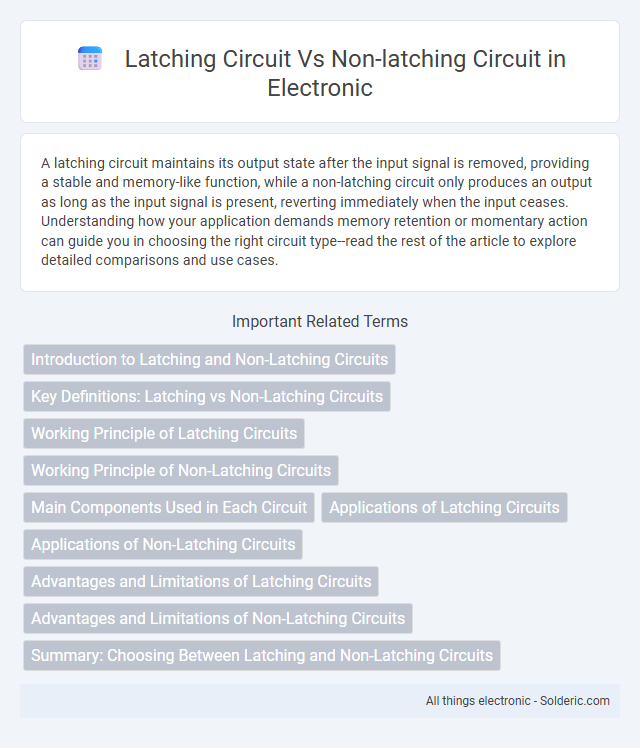A latching circuit maintains its output state after the input signal is removed, providing a stable and memory-like function, while a non-latching circuit only produces an output as long as the input signal is present, reverting immediately when the input ceases. Understanding how your application demands memory retention or momentary action can guide you in choosing the right circuit type--read the rest of the article to explore detailed comparisons and use cases.
Comparison Table
| Feature | Latching Circuit | Non-Latching Circuit |
|---|---|---|
| Definition | Maintains output state after input is removed | Output state returns to original when input is removed |
| Output Stability | Stable, holds logic state | Temporary, changes only during input presence |
| Application | Memory elements, switches, flip-flops | Signal processing, momentary actions |
| Control | Requires separate reset or set signal | Automatically resets with input removal |
| Power Consumption | May consume power to hold state | Consumes power only during input activation |
| Complexity | More complex design | Simpler design |
| Examples | SR latch, flip-flop circuits | Monostable multivibrator, push-button circuits |
Introduction to Latching and Non-Latching Circuits
Latching circuits maintain their output state even after the input signal is removed, storing the information until reset, making them essential in memory and control applications. Non-latching circuits respond to input signals only while those signals are present, reverting to their original state once the input ceases, which suits temporary switching actions. Understanding the difference between latching and non-latching circuits helps you choose the appropriate design for stable data retention or momentary activation needs.
Key Definitions: Latching vs Non-Latching Circuits
Latching circuits maintain their output state even after the input signal is removed, using feedback mechanisms to "latch" the output until reset. Non-latching circuits change their output only while the input signal is present, reverting to the original state once the input is removed. This key difference makes latching circuits ideal for memory storage and toggle functions, whereas non-latching circuits suit momentary switching applications.
Working Principle of Latching Circuits
Latching circuits operate by maintaining their output state even after the input signal is removed, using feedback mechanisms such as cross-coupled gates or flip-flops to "lock" the output. This working principle allows the circuit to store a binary state, making it essential in memory storage, switch debouncing, and control applications. In contrast, non-latching circuits produce outputs directly dependent on input signals without retaining previous states.
Working Principle of Non-Latching Circuits
Non-latching circuits operate by maintaining their output state only while the input signal is applied, reverting immediately once the signal is removed. These circuits rely on momentary input triggers, causing temporary changes in output without retaining state or memory. Common examples include push-button switches and sensor outputs that reset instantly after activation ceases.
Main Components Used in Each Circuit
Latching circuits typically use components such as flip-flops, relays, or transistors to maintain their state once activated, ensuring the output remains stable without continuous input signals. Non-latching circuits primarily rely on momentary devices like push buttons or sensors that only provide output while the input is present, often utilizing simple switches or timers. Your choice between these circuits depends on the need for persistent output versus temporary activation, which dictates the specific components required.
Applications of Latching Circuits
Latching circuits find extensive applications in memory storage, switch debouncing, and flip-flop implementations due to their ability to maintain a stable output state even after the input signal is removed. They are widely used in digital systems for data retention, such as in registers and memory cells, providing reliable state preservation crucial for sequential logic operations. Industrial control systems and electronic locks also utilize latching circuits to ensure consistent performance without requiring continuous power or input signals.
Applications of Non-Latching Circuits
Non-latching circuits are widely used in applications where temporary or momentary control signals are required, such as push-button switches, alarm systems, and pulse generation. These circuits return to their original state immediately after activation, ensuring that devices like indicator lights or relays only operate while the input is present. Your projects benefit from non-latching circuits when you need precise control without retaining the output state after the input is removed.
Advantages and Limitations of Latching Circuits
Latching circuits maintain their output state even after the input signal is removed, providing advantages such as reduced power consumption and reliable memory retention in digital systems. They offer non-volatile behavior, making them ideal for switch debouncing, memory storage, and toggle controls. However, limitations include potential complexity in design, slower response times compared to non-latching circuits, and susceptibility to unintended state changes due to noise or signal glitches.
Advantages and Limitations of Non-Latching Circuits
Non-latching circuits offer simplicity and faster response times due to their straightforward design without memory retention, making them ideal for applications requiring immediate state changes. However, they lack the ability to maintain their output state after the input is removed, which limits their use in scenarios needing stable, sustained signals. You should choose non-latching circuits for tasks emphasizing quick reset and minimal complexity, while acknowledging their limitation in state persistence.
Summary: Choosing Between Latching and Non-Latching Circuits
Latching circuits maintain their output state after the input signal is removed, making them ideal for memory storage and toggle applications. Non-latching circuits immediately revert to their original state when the input is removed, suitable for momentary or trigger operations. Your choice depends on whether you need persistent or temporary state retention in your electronic design.
latching circuit vs non-latching circuit Infographic

 solderic.com
solderic.com